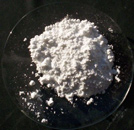  Calcium Carbonates Calcium Carbonates
Calcium carbonate (CaCO3) is a chemical compound of calcium. It is the main component of the shells of marine organisms such as oysters, snails shells, pearls, coral and eggshell. Calcium carbonate occurs as minerals aragonite and calcite. These carbonate minerals form the rock types of limestone, chalk, marble, travertine, tufa and coquina. Read on and enjoy these interesting calcium carbonate facts. | | |
Aragonite | Aragonite is one of two common naturally occurring calcium carbonate minerals. It forms as a needle-like crystal and will change to calcite at 380 - 470°C. Biologically, aragonite is found in almost all marine mollusk shells, and in corals. It is also found in various cave formations. Aragonite is often used to recreate reef conditions (corals) in aquariums. | | Calcite | Calcite is the most stable of the two common naturally occurring calcium carbonate minerals. Calcite crystals form as hexagonal-like shapes. Calcite is the main mineral in the shells of marine organisms (eg. plankton, oysters, sponges, etc.) and therefore makes up much of the sedimentary rock limestone and is the main mineral in metamorphic marble. It is also found as vein deposits from hot springs activity, and occurs in caves as stalactites/stalagmites. Like other carbonates, calcite will dissolve in most forms of acid. | | Limestone | Limestone is made mostly of the minerals calcite and aragonite. Around 10% of all sedimentary rock is limestone which is mainly composed from skeletal shell fragments of marine organisms. It is therefore known to have formed on the bottom of ancient oceans and seas where it was uplifted over millions of years to become rock on land. Most cave systems and karst landscapes form in limestone bedrock as the calcium carbonates in limestone erodes away in weakly acidic groundwater. There are two main classifications for identifying different limestone, the Folk and the Dunham. Limestone is used as building material, when making roads, and as white pigment in products like toothpaste and cosmetics. The Great Pyramids have a layer of limestone and many european medieval churches and castles are made of the rock. | | Marble | As tectonic processes form mountains extreme pressures and heat on limestone bedrock re-crystallizes the carbonate minerals such as calcite that makes up the limestone, turning the sedimentary rock into metamorphic rock called marble. Marble is commonly used in sculpture, since classical times white marble has been prized as it is quite easy to carve and looks great. Marble is also used as a building material, the Taj Mahal is entirely clad in marble. Italy produces the most marble each year followed by China, India and Spain. | | Chalk | Chalk is a soft, white, and porous type of limestone. Because chalk has a greater resistance to weathering and slumping than clays, it is often found forming tall steep cliffs at the sea edge. The famous White Cliffs of Dover in Kent, England are chalk cliffs. The Champagne region of France sits on chalk deposits, in which artificial caves are created to store wine. Blackboard chalk was traditionally made of natural chalk, however, modern chalk is usually made from the mineral gypsum. | | Travertine | Travertine is a variety of limestone that forms usually near waterfalls in hot spring mineral-rich streams. Calcium carbonate calcite is deposited as evaporation of the water leaves the mineral. Pamukkale in Turkey, is one of the best examples in the world of travertine rock deposits. It can also form in cave systems when dripping mineral-rich water walls, stalactites/stalagmites. It is often used as a building material particularly in Italy. The Romans mined travertine for building temples, monuments, bath complexes, and amphitheaters such as the Colosseum. | | Tufa | Tufa is similar to travertine limestone, but is usually softer and much more porous, forming in more normal water temperatures. It forms near spring stream channels or near lakes as columns and mound formations. | | Coquina | Normally found on the coast, coquina is a weakly compacted limestone made of large pieces (over 2mm in size) of coral or shells. It has been used as a building material in the past, but being so soft and crumbly it usually has to be dried out for 3 years to become hard enough to use. | |
|